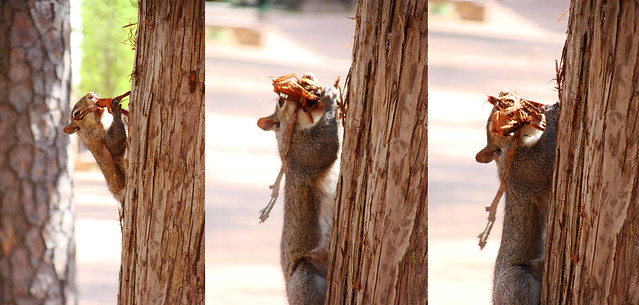When squirrel-tree relationships turn bad
By Mary Hightower
(440 words)
LITTLE ROCK – Some days a tree’s bark is no match for a squirrel’s bite.
"Squirrels, and in particular gray squirrels, are known to strip bark from trees,” said Becky McPeake, extension wildlife specialist for the University of Arkansas System Division of Agriculture.
“Their behavior can harm trees, especially when their debarking girdles a tree,” completely removing the tree’s outer protective layer, she said. “It can lead to timber degradation and decrease tree health, which may affect timber value, but most of the time, damage severity appears to be low.”
One squirrel spotted on the campus of the University of Arkansas at Little Rock on April 10 was doing just that, stripping a cypress tree’s bark with its paws and teeth.
Bark protects the living inner part of the tree that grows and transports water and nutrients.
“Stripping the bark allows the exposed living tissue to dry out and die,” said Jon Barry, extension forester with the Division of Agriculture. “These wounds also create entry points for pests and infections and the chemicals evaporating from the sap of the tree can attract additional pests.”
Still, "it's quite a mystery as to why squirrels debark a tree. It could be for a variety of reasons,” McPeake said, “and damage levels vary between years and seasons.”
One theory is that squirrels are seeking water or nutrients. In some areas, damage occurs in early spring, when there is an abundant flow of sap.
"Squirrels like tree sap. Where maple syrup is harvested in the northeastern U.S., squirrels cause problems by gnawing through the tubes where sap is collected,” she said.
Or “perhaps there is some other nutritional need being satisfied,” McPeake said, however, “there seems to be no relation between a food shortage for squirrels and debarking behavior, according to some studies.”
There’s another theory that the omnivorous squirrels strip dead bark to obtain fungi or insects. Or perhaps the squirrel is in need of nesting material.
Barry concurs with the nest material theory. “Bald cypress bark is soft, so I wonder if the squirrel was collecting material to build a nest,” he said. “I’m not aware of bald cypress being unusually high in sugars or anything else. The sap may have a sweet taste as it is carrying energy from the roots to the developing leaves.”
McPeake said that in Arkansas, “the first litter is typically born from mid-February until April, so one would think collecting nest material would be completed by mid-April. So it could be starting on its second nest. Another theory is that pregnant squirrels chew the bark to cope with pain.”
For more information on managing wildlife, visit www.uaex.uada.edu or contact your county extension office.
Arkansas Cooperative Extension Service is an equal opportunity institution. If you require a reasonable accommodation to participate or need materials in another format, please contact your County Extension office (or other appropriate office) as soon as possible. Dial 711 for Arkansas Relay.
Pursuant to 7 CFR § 15.3, the University of Arkansas System Division of Agriculture offers all its Extension and Research programs and services (including employment) without regard to race, color, sex, national origin, religion, age, disability, marital or veteran status, genetic information, sexual preference, pregnancy or any other legally protected status, and is an equal opportunity institution.
# # #
Media Contact: Mary Hightower
Dir. of Communication Services
U of A Division of Agriculture
Cooperative Extension Service
(501) 671-2126
mhightower@uada.edu
Related Links
